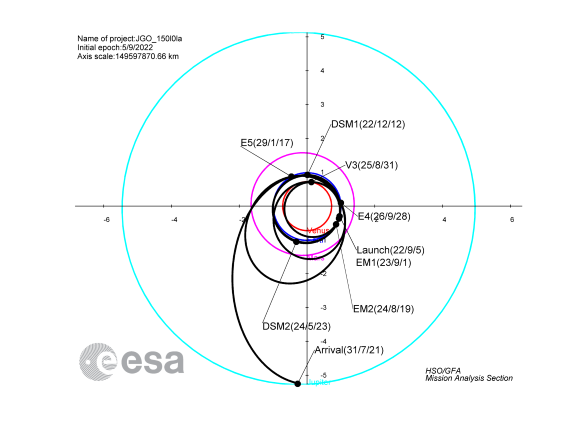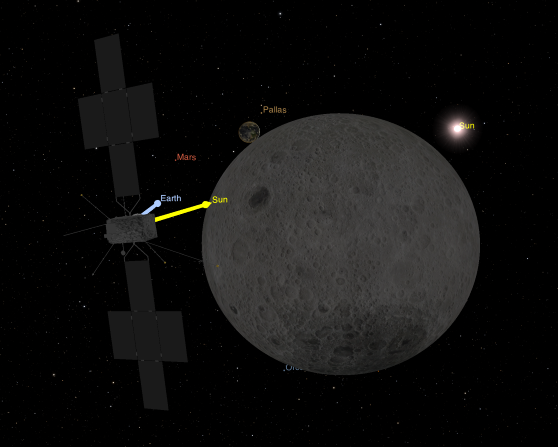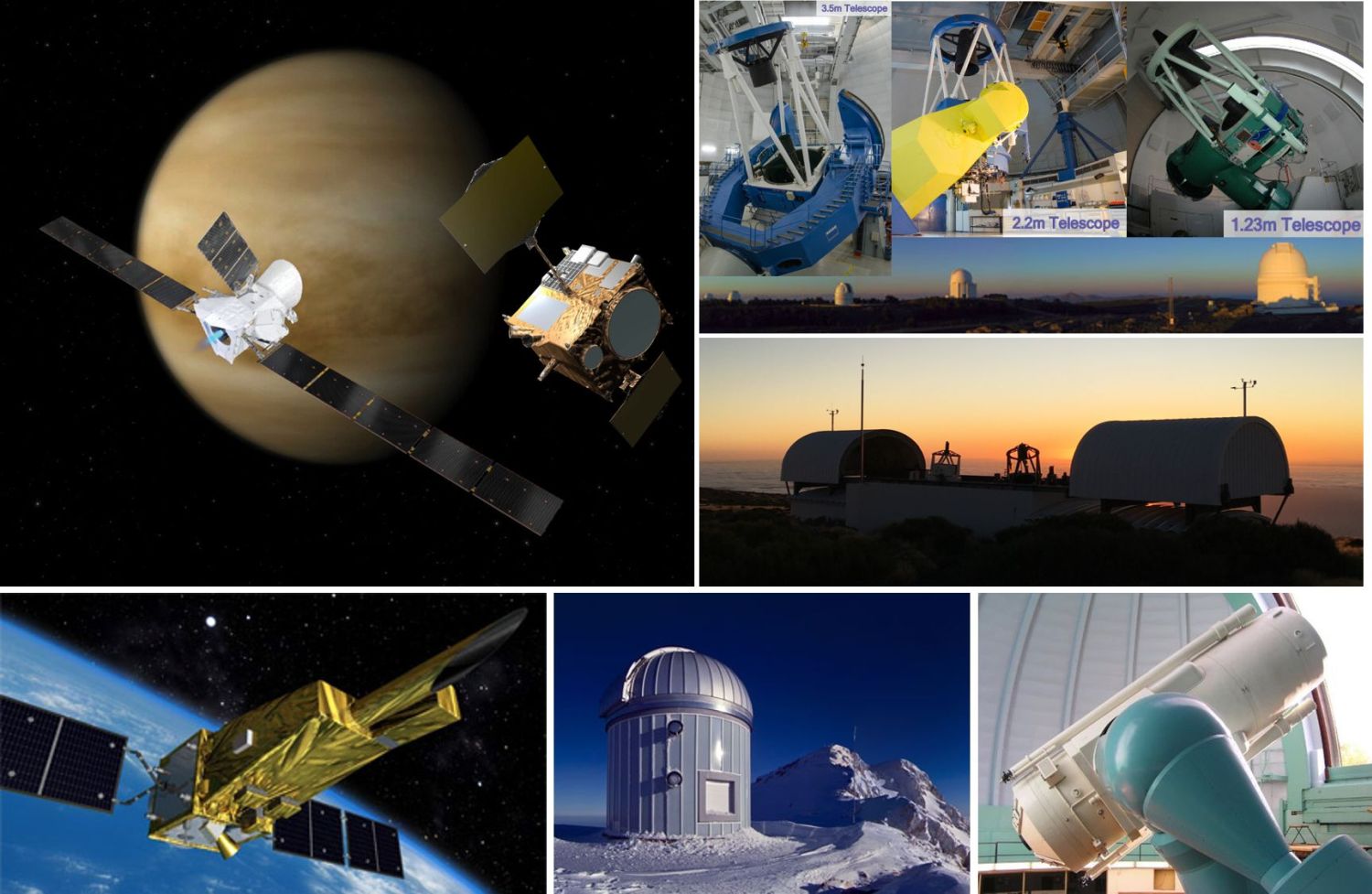Olivier Witasse, Nicolas Altobelli, Rafael Andres, Alessandro Atzei, Arnaud Boutonnet, Frank Budnik, Angela Dietz, Christian Erd, Ry Evill, Rosario Lorente, Claudio Munoz, Giulio Pinzan, Carsten Scharmberg, Ander Suarez, Ignacio Tanco, Felice Torelli, Ben Torn, and Claire Vallat and the JUICE Science Working Team
JUICE - JUpiter ICy moons Explorer - is the first large mission in the ESA Cosmic Vision 2015-2025 programme. The mission was selected in May 2012, and is now (May 2021) in the final stages of its integration and testing campaigns. Following its arrival at Jupiter in July 2031, JUICE will spend 4.2 years making detailed observations of Jupiter and three of the Galilean moons, Ganymede, Callisto and Europa. We present here the plan of activities to be carried out during the interplanetary cruise phase.
1. Trajectory during the cruise phase
The mission will be launched from Kourou with an Ariane 5. The baseline launch window is between 26 August – 15 September 2022, with a backup launch slot in August 2023. The interplanetary transfer sequence relies on gravity assist manoeuvres with Venus, Earth and the Moon. The Jupiter orbit insertion will be performed in July 2031. The cruise phase officially starts after the end of the near-Earth commissioning (launch + 3 months) and ends six months before the Jupiter orbit insertion, when the nominal science mission begins.
The list of planetary gravity assists is given in Table 1:
|
Date
|
Planet
|
Pericenter altitude [km]
|
|
01/09/2023
02/09/2023
|
Moon
Earth
|
300
180,000
|
|
23/08/2024
|
Earth
|
13,400
|
|
31/08/2025
|
Venus
|
5,100
|
|
29/09/2026
|
Earth
|
8,600
|
|
18/01/2029
|
Earth
|
4,600
|
2. Spacecraft and mission constraints during the cruise phase
The main limitations during the cruise phase are:
- Priority of operations in support of navigation and spacecraft safety, especially in the preparation of gravity assist manoeuvres, in particular the world premiere of Lunar-Earth gravity assist
- The thermal design of the spacecraft which imposes, for heliocentric distances lower than 1.34 AU, restricted pointing capabilities and limitations in the number of instruments that can operate simultaneously.
- Quiet Cruise baseline: Reduced number of ground contacts (one ground station pass per week except for planetary flybys).
- Operational constraint to minimize the use of the mass memory during Cruise to preserve unit lifetime, limiting the possibility to operate the instruments and store their data.
- Budgetary restrictions that result in small operation teams during this phase.
The baseline operations of the instruments are two one-week checkouts per year. It is expected that at least some of the observations will take place during the planetary flybys, with different possibilities still under study. The requests for operating the payload beyond this baseline will be carefully analyzed and agreed on a best-effort basis. The next section gives example of possible observations.
3. Potential scientific investigations to be performed during the cruise phase
Instrument operations during the cruise phase are always useful: they allow calibrating instruments in known environments (e.g. solar wind, Earth’s magnetosphere), checking possible interferences between instruments, they provide scientific results (sometimes not expected and outstanding, resulting in high standard publications) and attract public attention. During the long cruise phase of the JUICE mission, a number of scientific opportunities have been identified, beyond the obvious case of the planetary flybys. They include: solar wind campaigns, neutral atoms imaging in the heliosphere, measurement of Jovian escaping relativistic electrons, measurements of interplanetary dust, test of the general relativity around solar conjunctions, observation of the cosmological radio background, and an asteroid flyby (to be further studied).
4. JUICE teams activities during the cruise phase
The JUICE teams (mission operation center, science operations center, instrument teams, science working team, working groups, project scientist and mission manager) will be busy with numerous activities. A non-exhaustive list is given below:
- Spacecraft navigation and operations in the inner solar system, including planetary flybys and payload checkouts;
- Decision about an asteroid flyby (shortly after launch);
- Analysis of the cruise data, instrument calibration, scientific analysis, publication and archive;
- Refinement and agreement (three years before Jupiter orbit insertion) on the trajectory within the Jupiter system;
- Preparation of the science planning of the nominal mission and of the science analysis of the future data;
- Studying and preparing the coordination with ground-based and space observatories;
- Publication of a special issue with mission, instruments and science articles;
- Recruitment of guest investigators and of potentially additional interdisciplinary scientists;
- Continue the fruitful collaboration with the NASA Clipper teams.
- Conclusions
The JUICE cruise phase, despite its long duration (9 years), will be busy with many activities, with the goal of being fully ready to start the scientific observations from early 2031 onwards.
Figures

Figure 1: Evolution of distances (in AU) between the Sun, the Earth, Jupiter and JUICE as a function of time.

Figure 2: Overall cruise projected in the ecliptic frame

Figure 3: Lunar-Earth flyby in 2023

Figure 4: Illustration of the 300 km lunar flyby in 2023. The lunar and Earth disks are dark due the Sun position.




